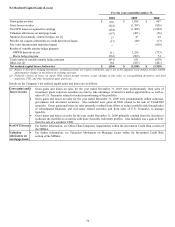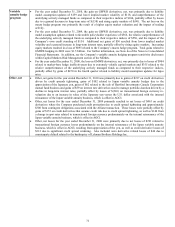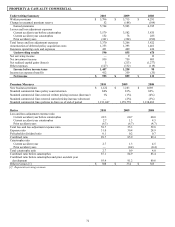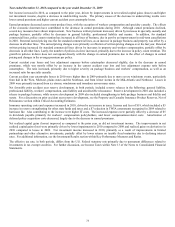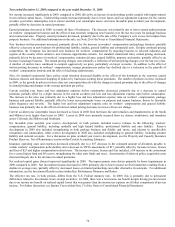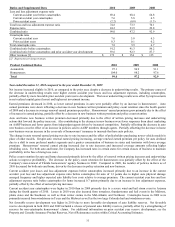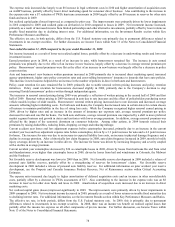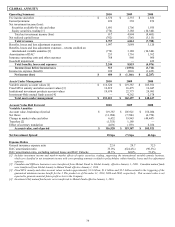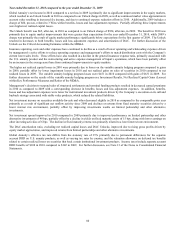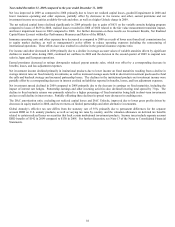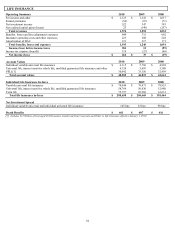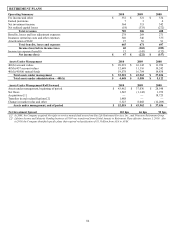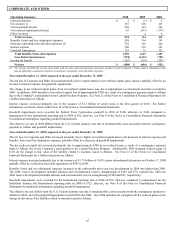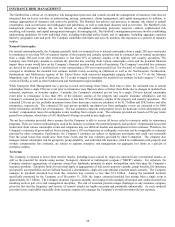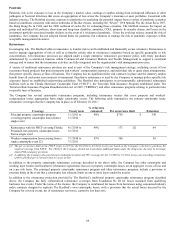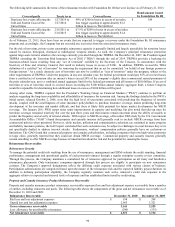The Hartford 2010 Annual Report Download - page 80
Download and view the complete annual report
Please find page 80 of the 2010 The Hartford annual report below. You can navigate through the pages in the report by either clicking on the pages listed below, or by using the keyword search tool below to find specific information within the annual report. 80
Year ended December 31, 2010 compared to the year ended December 31, 2009
Global Annuity’ s net income in 2010 compared to a net loss in 2009 is primarily due to significant improvements in the equity markets,
which resulted in an Unlock benefit in 2010 as compared to an Unlock charge in 2009, as well as continued market value appreciation in
account value resulting in increased fee income, and due to continued expense reduction efforts in 2010. Additionally, 2009 includes a
charge of $60, pre-tax, related to 3 Wins within benefits, losses and loss adjustment expenses. Partially offsetting these improvements
were higher net realized capital losses.
The Unlock benefit was $65, after-tax, in 2010 as compared to an Unlock charge of $924, after-tax, in 2009. The benefit in 2010 was
primarily due to equity market improvements that were greater than expectations for the year ended December 31, 2010, while 2009’ s
charge was primarily the result of equity market performance significantly below expectations for the first quarter of 2009. The Unlock
resulted in decreases to both benefits, losses and loss adjustment expenses and amortization of DAC. For further discussion of the
Unlock see the Critical Accounting Estimates within the MD&A.
Insurance operating costs and other expenses have continued to decline as a result of lower operating and wholesaling expenses driven
by management’ s active efforts to reduce operating expenses and management’ s efforts to match distribution costs with the Company’ s
current lower sales levels. These efforts have also resulted in a decline in the general insurance expense ratio, primarily associated with
the U.S. annuity product and the restructuring and active expense management of Japan’ s operations, which have been partially offset
by an increase in the average asset base from continued improvements in equity markets.
The higher net realized capital losses in 2010 were primarily due to losses on the variable annuity hedging program compared to gains
in 2009, partially offset by lower impairment losses in 2010 and net realized gains on sales of securities in 2010 compared to net
realized losses in 2009. The variable annuity hedging program losses were $451 in 2010 compared with gains of $631 in 2009. For
further discussion on the results of the variable annuity hedging program see Investment Results, Net Realized Capital Gains (Losses)
within Key Performance Measures and Ratios of the MD&A.
Management’ s decision to suspend sales of structured settlements and terminal funding products resulted in decreased earned premiums
in 2010 as compared to 2009 with a corresponding decrease in benefits, losses and loss adjustment expenses. In addition, benefits,
losses and loss adjustment expenses were lower for institutional investment products driven by the Company’ s execution on its call and
buyback strategy associated with stable value products, which reduced the related liabilities.
Net investment income on securities available-for-sale and other decreased slightly in 2010 as compared to the comparable prior year
primarily as a result of significant net outflow activity since 2009 and declines on returns from fixed maturity securities driven by a
lower interest rate environment, partially offset by improving investments results on limited partnership and other alternative
investments.
Net investment spread improved in 2010 compared to 2009 primarily due to improved performance on limited partnership and other
alternative investments of 48 bps, partially offset by a decline in yields on fixed maturity assets of 15 bps, along with lower earnings on
other investing activities of 6 bps. The decline in fixed maturity returns was primarily related to a lower interest rate environment.
The DAC amortization ratio, excluding net realized capital losses and DAC Unlocks, improved due to rising gross profits driven by
equity market appreciation, and improved returns from limited partnerships and other alternative investments.
Global Annuity’ s effective tax rate differs from the statutory rate of 35% primarily due to permanent differences for the separate
account DRD on U.S. annuity products, as well as varying tax rates by country, and the valuation allowance on deferred tax benefits
related to certain realized losses on securities that back certain institutional investment products. Income taxes include separate account
DRD benefits of $108 in 2010 compared to $142 in 2009. For further discussion, see Note 13 of the Notes to Consolidated Financial
Statements.


